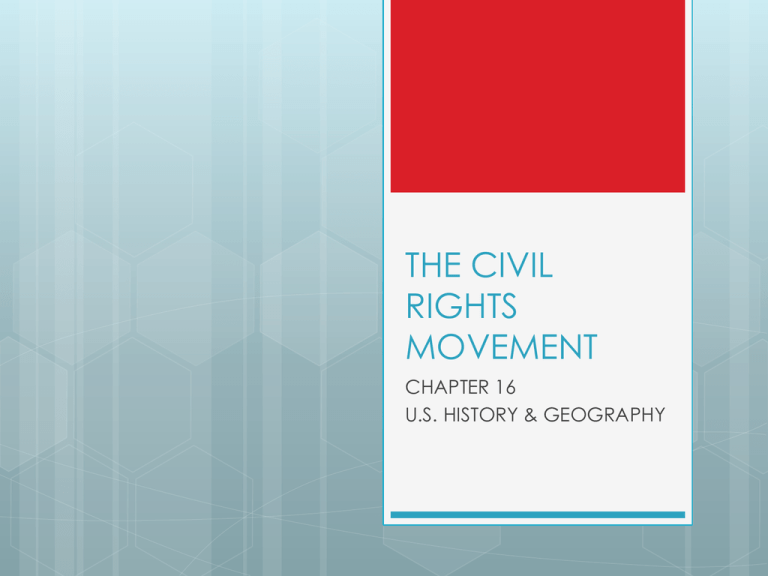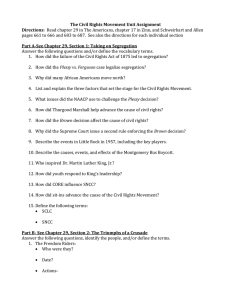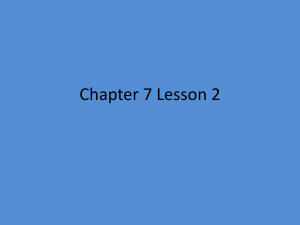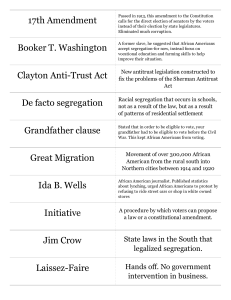the civil rights movement
advertisement

THE CIVIL RIGHTS MOVEMENT CHAPTER 16 U.S. HISTORY & GEOGRAPHY ORIGINS OF THE MOVEMENT They are fighting the decision by the U.S. Supreme Court – Plessy v. Ferguson 1896 – that declared that segregation was constitutional & established the “separate but equal” doctrine. This allowed for the Jim Crow laws to be passed throughout states. These laws forbade things like marriage between blacks & whites, restrictions on social & religious contact, separate schools, streetcars, buses, waiting rooms, railroad coaches, witness stands, public restrooms, etc. ORIGINS OF THE MOVEMENT Events of WWII: demand for workers filled in part by African Americans, serving in the Armed Forces honorably during the war, civil rights organizations were actively campaigning against Jim Crow laws & obtaining voting rights. African Americans were not just fighting de jure segregation – segregation by law- but also fighting de facto segregation – segregation by custom and tradition – in many areas which is much more difficult. COURT CHALLENGES BEGIN NAACP had some victories throughout their fights in court over segregation Norris v. Alabama 1935 – concluded that exclusion of African Americans from juries violated their rights to equal protection under the law Morgan v. Virginia 1946 – declared unconstitutional state laws mandating segregated seating on interstate buses NEW POLITICAL POWER African Americans would use their right to vote to assist them in increasing their political power especially in the North where politicians would listen to their concerns so as to obtain their votes. Benefits form New Deal programs that aided African Americans caused African Americans to begin supporting the Democratic Party PUSH FOR DESEGREGATION Congress of Racial Equality (CORE), founded by James Farmer & George Houser began using sit-ins in 1942 to start the process to desegregate restaurants that refused to serve African Americans. The sit-in strategy surfaced from strikes in industry that were used to get workers what they were asking for. Successes were found mostly in many northern cities (Chicago, Detroit, Denver, & Syracuse) BROWN V. BOARD OF EDUCATION, TOPEKA, KS Thurgood Marshall would lead the NAACP in several Supreme Court cases as the NAAVP’s chief counsel focusing his efforts on ending segregation in public schools. Brown v. Board of Education, May 17, 1954: Linda Brown was denied admission to her neighborhood school because of her race in Topeka, KS. U.S. Supreme Court combined several cases dealing with the same issue and ruled that “separate but equal” had no place in public schools as the educational facilities were inherently unequal. This decision applied only to public schools but it would threaten the entire system of segregation SEE PG. 381 SOUTHERN RESISTANCE Resistance to the Supreme Court’s decision would begin throughout the South and an effort to defy the decision would be encouraged by citizens and politicians States would adopt pupil assignment laws which created other requirements for admission into schools other than race as an effort to keep African Americans from attending “white” schools In 1955, Supreme Court ordered school districts to desegregate “with all deliberate speed”. Wording is so vague that many districts would be able to keep their schools desegregate for many years. SOUTHERN RESISTANCE “Southern Manifesto” was signed by 101 Southern members of Congress denouncing the Supreme Court’s ruling as an abuse of judicial power and would use all lawful means to reverse decision It isn’t until 1969 that the U.S. Supreme Court orders all school systems to desegregate at once and operate integrated schools MONTGOMERY BUS BOYCOTT December 1, 1955: Rosa Parks was arrested in Montgomery, Alabama for refusing to give up her seat to a white man that was against the law. NAACP would use Parks’ arrest as challenge to segregation & it would spark a new era in the Civil Rights movement. Montgomery Improvement Association will run the boycott and negotiate with city leaders. Martin Luther King, Jr. would be elected to take the lead. Martin encouraged the people to continue the protest but it had to be through non-violent passive resistance MONTGOMERY BUS BOYCOTT Boycott will continue for over a year. In November 1956, U.S. Supreme Court ruled that Alabama’s laws requiring segregation on buses unconstitutional Many cities in South, successful resisted the ruling for years AFRICAN AMERICAN CHURCHES African American churches served as staging areas for protests, planning meetings, and mobilizing volunteers. Many African American ministers, other than Martin Luther King, Jr., would take the lead in organizing the non-violent protests, like the bus boycott. Southern Christian Leadership Conference (SCLS), 1957: formed by Dr. King, Reverend Shuttlesworth and other African American ministers and civil rights activists to eliminate segregation and encourage African Americans to register to vote. They challenged segregation in the areas of voting, public transportation, housing, and other areas. EISENHOWER RESPONDS Eisenhower felt that sympathy towards the movement but feared the effects a court ruling overturning segregation could have. He believed that segregation & racism would end gradually and did not want to divide the nation. Eventually, Eisenhower knew that he had to uphold the authority of the federal government and will be the first president since Reconstruction to send troops into the South to protect rights of African Americans CRISIS IN LITTLE ROCK September 1957: Court order issued requiring Central High to admit nine African American students. Governor Orval Faubus was campaigning for his reelection as a defender of white supremacy and ordered Arkansas National Guard to prevent the nine student s from entering the school. An angry mob had gathered to intimidate the students. Faubus’ use of the National Guard to oppose the federal government was the first since the Civil War. Little Rock High School Photograph courtesy of Little Rock Central High School Museum and Visitor's Center One of the "Little Rock Nine" braves a jeering crowd Photograph by and courtesy of Will Counts President Eisenhower and Arkansas Governor Faubus at their meeting in Newport, Rhode Island, September 14, 1957 A Negro newsman is attacked by mob Photo by Ira Wilmer - courtesy of Arkansas Democrat-Gazette U.S. Army troops from the 101st Airborne Division disperse a crowd in front of Little Rock's Central High School. CREDIT: "Three men are driven from Central High School area in Little Rock at bayonet point today by 101st Airborne Division troops." 1957. New York World-Telegram and the Sun Newspaper Photograph Collection. Prints and Photographs Division, Library of Congress. CRISIS IN LITTLE ROCK Eisenhower attempted phone conferences to resolve the situation which did not work. District court ordered the governor to remove the troops and Faubus left the school to the mob. The nine African American students entered the school and the mob turned violent. Eisenhower would act and send the U.S. Army to Little Rock and federalized the Arkansas National Guard. The army encircled the school and provided protection for the students. Federal authority had been upheld but the army had to stay there the rest of the year. NEW CIVIL RIGHTS LEGISLATION Civil Rights Act of 1957 was intended to protect the right of African Americans to vote. Senate majority leader Democrat Lyndon Johnson put together a compromise of the bill that would allow it to pass Congress. Final Form: weaker than originally intended; brought the power of federal government into civil rights debate; Civil Rights Division created within the Department of Justice that is given the authority to obtain court injunctions against anyone interfering with the right to vote; United States Commission on Civil Rights is created to investigate denial of voting rights. SCLC would begin a campaign to register new African American voters. SIT-IN MOVEMENT February 1, 1960, Greensboro, North Carolina: Four African Americans entered the Woolworth’s store, purchased school supplied and then sat at the white’s only lunch counter and ordered coffee. They were refused service and sat there until the store closed, promising to be back until they were served. News of the sit-in spread quickly and the number of participants grew dramatically. The "Greensboro Four" waiting to be served at Woolworth's Photograph by John G. Mobius, reprinted with permission of the News & Record, Greensboro, NC. SIT-IN MOVEMENT Sit-in’s conducted by young college students would then begin to occur across the country in different cities. NAACP and the SCLC were concerned about the sit-ins as many were beaten, burned, punched, etc. Ella Baker, former NAACP and SCLC executive director, will establish the Student Nonviolent Coordinating Committee (SNCC) in 1960 that would assist in the sit-ins and assist in registering African Americans in obtaining their voting rights. This group consisted of young African Americans and young whites. FREEDOM RIDERS Laws outlawing segregation on interstate bus service were largely ignored in the South where bus terminals were still segregated. Alabama was still segregated and the governor, John Patterson, was determined to keep it that way. Freedom Riders - May 1961: Team of African Americans and white volunteers boarded buses and headed south on interstate buses where they were met by angry white mobs in Anniston, Birmingham, and Montgomery, Alabama. Anniston’s bus had a firebomb thrown at it. In the other stops the riders would be beaten. The violence made national news drawing the federal government back into the issue of segregation in the South KENNEDY & CIVIL RIGHTS JFK ran for office on the premise that he would support civil rights. JFK also knew that he needed Southern senators vote to get other programs passed in Congress and new civil rights legislation would hinder that. JFK did give African Americans high-level government positions, appointed Thurgood Marshall to a federal judgeship on the Second Circuit Appeals Court (NY), and created the Committee on Equal Employment Opportunity. The Justice department, ran by Robert his brother, was to support the civil rights movement and filed many lawsuits across the South to aide African Americans in registering to vote. KENNEDY & CIVIL RIGHTS JFK wanted a “cooling off” period after attacks of Freedom Riders but James Farmer, leader of CORE, said no and continued the rides into Mississippi. JFK made a deal with Mississippi that in exchange for no violence that he would have no issue if they were arrested. Thurgood Marshall allowed for CORE to continue the rides by giving them access to NAACP bail funds. JFK would then order the Interstate Commerce Commission to enforce the regulations and bring an end to the segregated bus terminals which occurred around 1962. VIOLENCE IN BIRMINGHAM Spring of 1963, MLK, JR. began to lead demonstrations in Birmingham, AL which provoked a violent response. MLK would be arrested and while in jail wrote a letter “Letter from Birmingham Jail” where he discussed two types of laws, just and unjust, defined them, and why individuals had a moral responsibility to disobey unjust laws. Eventually MLK was released and the protests began again and grew in number. Alabama responded with violence using clubs, police dogs, and fire hoses on the demonstrators. VIOLENCE IN BIRMINGHAM Children’s March - May 2, 1963: Young African Americans marched in groups in downtown Birmingham. They would be attacked by police and arrested. On May 3, a second “children’s crusade” came face to face with helmeted police force where the children were brutally attacked. ALL captured on television news reels. Civil Rights Leaders Dr. Martin Luther King, Jr., Whitney Young, and James Farmer meeting with President Lyndon Johnson Photograph by Yoichi R. Okamato Photograph courtesy of National Archives and Records Administration, LBJ Library, #W425-21 CIVIL RIGHTS ACT 1964 June 11, 1963: George Wallace, governor of AL, stated at his inauguration “….Segregation now! Segregation tomorrow! Segregation forever!” He fulfilled this by standing in front of the door way to the University of Alabama blocking two African Americans from enrolling. He was forcibly removed by federal marshals. JUNE 11, 1963 Vivian Malone, one of the first African Americans to attend the university, walks through a crowd that includes photographers, National Guard members, and Deputy U.S. Attorney General Nicholas Wallace standing against desegregation while being confronted by Deputy U.S. Attorney General Nicholas Katzenbach at the University of Alabama in 1963 Katzenbach. CIVIL RIGHTS ACT 1964 June 12, 1963: Medgar Evers, NAACP’s first field secretary, was focusing work on voters registration in MI, will be killed. President Kennedy announces plans for a new Civil Rights bill MARCH ON WASHINGTON August 28, 1963: more than 250k demonstrators, African Americans & whites, march through Washington D.C. and gather at the Lincoln Memorial. Dr. King delivers his “I Have A Dream Speech” calling for freedom and equality for ALL Americans Two weeks later: Birmingham’s Sixteenth Street Baptist Church – September 15, 1963: KKK bombs the church, killing four African American girls. BILL BECOMES LAW Kennedy fails to pass his civil rights bill. However, after his assassination in November 1963, Lyndon Johnson will work to get the bill passed. The bill passes House of Representatives in February 1964. Senate attempts to do a filibuster which will fail. Senate then votes for a cloture, to end debate & vote, which easily passes. Senate then will vote pass the Civil Rights Bill. Lyndon Johnson signs the Civil Rights Bill of 1964 into law on July 2, 1964. President Lyndon Johnson signing the Civil Rights Act of 1964 into law, with Martin Luther King, Jr., looking on. Photograph by Cecil Stoughton Photograph courtesy of National Archives and Record Administration, LBJ Library #276-10-64 BILL BECOMES LAW The law makes segregation illegal in most [places of public accommodation, gave citizens of all races and nationalities equal access to public facilities, U.S. attorney general is given more power to force school desegregation, requires private employers to end discrimination in the work place, and established the Equal Employment Opportunity Commission (EEOC) as a permanent federal agency STRUGGLE FOR VOTING RIGHTS Voting rights will continue to be an issue despite the passage of the new Civil Rights law. Freedom Summer: College students who were trained in non-violent resistance would volunteer to assist African Americans in registering for their right to vote. June 1964: 3 civil rights workers, 2 were white, disappeared in Mississippi. It was learned later that KKK members & local police had murdered them. Twenty-Fourth Amendment to the U.S. Constitution will put an end to poll taxes in federal elections (but not state elections) SELMA MARCH December 1964: Dr. King receives the Nobel Peace Prize. SCLC and King select Selma, AL as the focal point for their voting rights campaign as the majority of the population in the city was African American yet they only made up 3% of registered voters. Sheriff Jim Clark would deputized & arm white citizens allowing them to use clubs & cattle prods on African Americans to terrorize them into not registering to vote or voting. The demonstrations would continue and more than 3k African Americans would be arrested. SELMA MARCH March 7, 1965: King will join with SNCC activists in organizing a “march for freedom” from Selma to Montgomery, state capital. Hosea Williams, SCLC, & John Lewis, SNCC, will lead the march across the Edmund Pettus Bridge where they were met by Sheriff Clark who ordered them to disperse. When they refused to disperse they would be beaten on live television cameras. This becomes known as “Bloody Sunday”. ALL caught by television crews & would air on national television. Demonstrators, black and white, would pour into Selma from around the country. Alabama police attack Selma-toMontgomery Marchers, 1965 Federal Bureau of Investigation Photograph SELMA MARCH Ten days later, Lyndon Johnson will appear to a joint session of Congress on national tv & propose a new voting rights bill On March 21 the march from Selma to Montgomery, AL would occur with federal protection & more than 25k joining in. VOTING RIGHTS ACT 1965 August 3, 1965: House of Representatives pass the voting rights bill. Next day, the Senate passes the bill. Voting Rights Act of 1965: authorizes the U.S. Attorney General to send federal examiners to register qualified voters, bypassing local officials, and it suspended discriminatory devices (i.e literary tests) Over 250k African Americans registered as new voters by the end of the year. Number of African Americans serving in the U.S. Congress will begin to rise as well URBAN PROBLEMS Despite the new laws, they were unable to change people’s attitudes allowing for racism to continue to exist. Urban poverty among African Americans would continue to rise as well. 70% lived in large cities Few allowed to live in white neighborhoods Many stuck in low-paying jobs. 15% worked in professional, managerial, or clerical jobs as compared to 44% of whites Average income was only 55% of that for white families. Unemployment rate generally was twice that of whites WATTS RIOTS August 8, 1965: 5 days after Johnson signs the Voting rights bill. In Watts, African American neighborhood in Los Angeles, a riot occurred over allegations of police brutality. More than 14k National Guard and 1500 law officers would be needed to restore order. KERNER COMMISSION Johnson will appoint Governor Otto Kerner over the National Advisory Commission on Civil Disorders to study the causes of urban riots. Kerner Commission blames racism for most of inner-city problems. Committee recommended the creation of inner-city jobs and public housing. These recommendations would go unfulfilled due to the spending of funds on the Vietnam War. SHIFT TO ECONOMIC RIGHTS King began to focus on economic problems faced by African Americans. To aide in drawing attention to it he moved his family into a “slum” neighborhood in Chicago. A march was down in an all-white suburb of Marquette Park was met by angry white mobs. Mayor Daley met with King to set up a new program to clean up the slums & associations of realtors & bankers agree to open housing. The theory was sound but what was put into practice, changed very little. BLACK POWER Lack of progress led many urban young people to look for other leaders & to move to other tactics. Many leaders wanted to use more aggressive tactics. Young African Americans called for black power which had several meanings. Some took it to mean implementing physical self-defense or that African Americans should control the social, political, & economic direction of their struggle. Black power stressed pride in African American culture. African Americans embraced their racial distinctiveness by changing their name, hairstyle, & clothing. BLACK POWER King considered black power as a philosophy of hopelessness & despair & objected to this movement as he believed that preaching violence could only end in grief. Black Panthers formed in October1966 by Huey Newton & Bobby Seale to fight against police brutality in the ghetto, advocate self-sufficiency, obtain full employment & decent housing, & maintain the belief that African Americans should be exempt from the draft to Vietnam as it was an unfair draft. MALCOLM X Born Malcolm Little in Omaha, NE 1946: sent to prison for burglary where he educated himself & participated in the prison debate society. Joins the Nation of Islam. This is very different from mainstream Islam as they preached about Black Nationalism. Changes his name to Malcolm X, the “X” symbolizing the family name of his enslaved African ancestors. His criticisms of white society & the civil rights movement assisted in gaining national attention for Nation of Islam. MALCOLM X 1964: Broke away from Nation of Islam due to the scandals involving their leader. Malcolm would no longer promoted separatism after making a trip to Makkah & saw first-hand that people could worship together. He would continue to criticize Nation of Islam & their members assassinated him in February 1965. Malcolm X’s speeches & ideas influenced new African American leaders like Huey Newton & Bobby Seale who organized the Black Panthers who called for an end to racial oppression & for control of major institutions like schools, law enforcement, housing, & hospitals. KING’S ASSASSINATION March 1968: King travels to Memphis, TN. To support a strike from African American sanitation workers. April 4, 1968: King is assassinated by a sniper while standing on the balcony of his hotel. After King’s death, Congress will pass the Civil Rights Act of 1968 that had a fair-housing provision outlawing discrimination in housing sales & rentals. The Civil Rights movement would begin to lack the unity of purpose & vision that King had given it after his passing.







